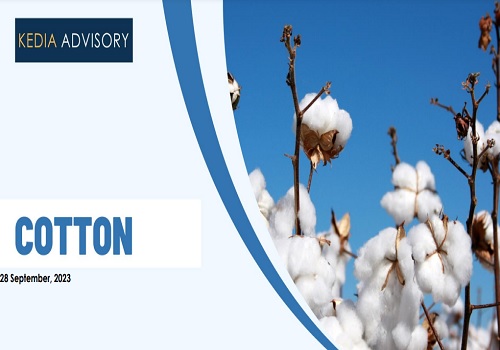Cotton Report by Amit Gupta, Kedia Advisory

* Cotton prices rose over 3% in a month as the cotton belt in Haryana, India, is grappling with an infestation of pink bollworms, adding to uncertainties in the cotton market.
* Cotton production in India is expected to decline due to factors such as reduced sowing area and pink bollworm infestations.
* The cotton sowing area in India has decreased from 127 lakh hectares to 124 lakh hectares, below the normal sowing area of 130 lakh hectares. O North Indian states like Haryana, Punjab, and parts of Rajasthan have been severely affected by pink bollworm infestations, leading to significant crop losses.
* In Sirsa district, Haryana, 60 percent of the cotton crop has been destroyed by pink bollworm. O New crop arrivals in North India are currently priced between 70-74 hundred per quintal, with expectations of reaching Rs 8 thousand per quintal.
* Madhya Pradesh experienced floods that broke a 200-year record, leading to submerged cotton crops and reduced production. O Sowing in Madhya Pradesh had increased by 4 percent to 6500 lakh hectares, but the floods have impacted production prospects.
* Gujarat, Maharashtra, and Madhya Pradesh have also started new crop arrivals with prices ranging from Rs 68-70 hundred per quintal.
* The Indian Cotton Federation predicts cotton production of 330 to 340 lakh bales in the 2023-2024 cotton season, with increased sowing area and MSP support.
* The textile industry in India faced low demand this year, leading to most units operating below capacity.
* Import of extra long staple cotton was affected by an 11% import duty, with some partial relaxation for imports from specific countries.
* There is a need to improve cotton yield in India by adopting best practices in cotton farming.
* Despite a recessionary trend, there has been a recent revival in the export of yarn and finished textile goods.
* The Central government has increased the Minimum Support Price (MSP) for cotton by 10%.
* USDA in its September WASDE report projected the global production to be 1.7 million bales lower for 2023-24
compared to the previous month.
O U.S. cotton production is forecasted to fall by 860,000 bales this month, with the Southeast and Southwest regions
leading the decline due to extreme weather events
Beginning Stocks: Beginning stocks for 2023/24 are higher, increased by 550,000 bales. This increase is primarily due to ending stocks data from the previous year and larger warehouse stocks for July 31, 2023.
Production: U.S. cotton production forecast is 860,000 bales lower compared to the previous month's projection. This decline is particularly pronounced in the Southeast and Southwest regions.
Consumption: The projected consumption for U.S. cotton remains unchanged from the previous month.
Exports: Exports for U.S. cotton are down by 200,000 bales compared to the previous month. Ending Stocks: Ending stocks for U.S. cotton are 100,000 bales lower compared to the previous month.
Price: The season-average price for upland cotton projected for 2023/24 is 80 cents per pound, which is an increase of 1 cent from the previous month's projection.
Beginning Stocks: World beginning stocks are approximately 1.0 million bales lower. This decrease is due to upward revisions in consumption for earlier years in China and Turkey, which more than offset the impact of larger U.S. and Brazil beginning stocks.
Production: World cotton production is projected to be 1.7 million bales lower. This reduction is attributed to decreases in production in the United States, India, the African Franc Zone, Greece, and Mexico, although there is an increase in production in Brazil. Consumption: World cotton consumption is also more than 1.0 million bales lower, with reductions observed in India, Bangladesh, Mexico, and Vietnam.
Trade: World cotton trade is down by 600,000 bales. This reduction is due to net import reductions for Bangladesh and Vietnam and export reductions for the Franc Zone, the United States, Australia, Greece, and Mexico. However, there is a 550,000-bale increase in exports for Brazil.
Ending Stocks: World ending stocks are 1.6 million bales lower for the month, totaling 90.0 million bales.





Tag News

Quote on FPI-FII details by Shrikant Chouhan, Head Equity Research, Kotak Securities



More News

Quote on Gold by Mr. Sandip Raichura, CEO - Retail Broking and Distribution, Director - PL B...









